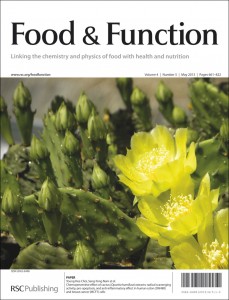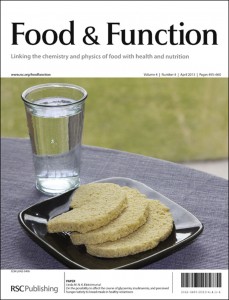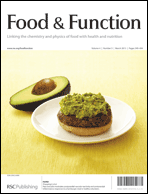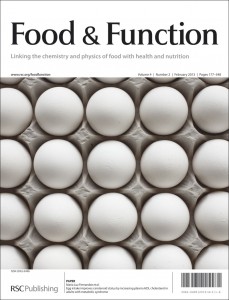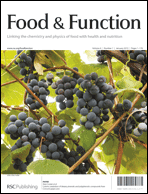For Food & Function, the top 10 most accessed articles in February were as follows:
Nuts, especially walnuts, have both antioxidant quantity and efficacy and exhibit significant potential health benefits
Joe A. Vinson and Yuxing Cai
Food Funct., 2012, 3, 134-140
DOI: 10.1039/C2FO10152A, Paper
Anti-inflammatory activity of natural dietary flavonoids
Min-Hsiung Pan, Ching-Shu Lai and Chi-Tang Ho
Food Funct., 2010, 1, 15-31
DOI: 10.1039/C0FO00103A, Review Article
Hass avocado modulates postprandial vascular reactivity and postprandial inflammatory responses to a hamburger meal in healthy volunteers
Zhaoping Li, Angela Wong, Susanne M. Henning, Yanjun Zhang, Alexis Jones, Alona Zerlin, Gail Thames, Susan Bowerman, Chi-Hong Tseng and David Heber
Food Funct., 2013, 4, 384-391
DOI: 10.1039/C2FO30226H, Paper
Transcription profiles of LPS-stimulated THP-1 monocytes and macrophages: a tool to study inflammation modulating effects of food-derived compounds
Wasaporn Chanput, Jurriaan Mes, Robert A. M. Vreeburg, Huub F. J. Savelkoul and Harry J. Wichers
Food Funct., 2010, 1, 254-261
DOI: 10.1039/C0FO00113A, Paper
Black tea: chemical analysis and stability
Shiming Li, Chih-Yu Lo, Min-Hsiung Pan, Ching-Shu Lai and Chi-Tang Ho
Food Funct., 2013, 4, 10-18
DOI: 10.1039/C2FO30093A, Review Article
Characterization of polarized THP-1 macrophages and polarizing ability of LPS and food compounds
Wasaporn Chanput, Jurriaan J. Mes, Huub F. J. Savelkoul and Harry J. Wichers
Food Funct., 2013, 4, 266-276
DOI: 10.1039/C2FO30156C, Paper
Review of in vitro digestion models for rapid screening of emulsion-based systems
David Julian McClements and Yan Li
Food Funct., 2010, 1, 32-59
DOI: 10.1039/C0FO00111B, Review Article
Effects of tea and coffee on cardiovascular disease risk
Siv K Bøhn, Natalie C Ward, Jonathan M Hodgson and Kevin D Croft
Food Funct., 2012, 3, 575-591
DOI: 10.1039/C2FO10288A, Review Article
Prior supplementation with long chain omega-3 polyunsaturated fatty acids promotes weight loss in obese adults: a double-blinded randomised controlled trial
Irene A. Munro and Manohar L. Garg
Food Funct., 2013, 4, 650-658
DOI: 10.1039/C3FO60038F, Paper
Pomegranate: a fruit that ameliorates metabolic syndrome
Svjetlana Medjakovic and Alois Jungbauer
Food Funct., 2013, 4, 19-39
DOI: 10.1039/C2FO30034F, Review Article
Take a look at the articles, and then let us know your thoughts and comments below.
Fancy submitting your own work to Food & Function? You can submit online today, or email us with your ideas and suggestions.











